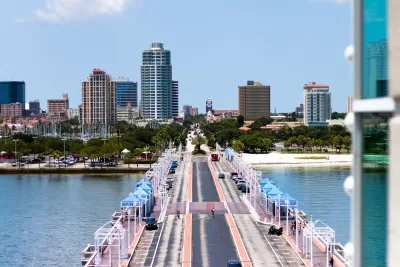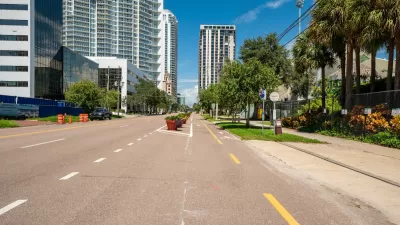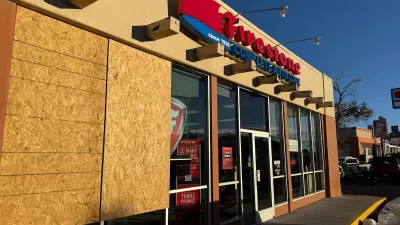Failing to receive protection from the St. Petersburg, Florida city council, a historic downtown block faces an uncertain future.

Downtown St. Pete's First Block, comprising 15 historic, low-rise structures in the heart of downtown, has failed to gain protection from potential redevelopment after the city council failed to support a bid to preserve the block. As Linda Saul-Sena of Creative Loafing writes, First Block is a magnet for "energy, activity and authenticity" with a number of bars and restaurants and a music venue anchoring the block. However, after a surprising 4-4 vote by the City Council, which leaves the block unprotected, the Mayor and preservationists are worried for the block's future. A report prepared by staff for the City Council in 2014 identified First Block as an ideal candidate for preservation.
The official city report states, ”The existing building array provides a highly distinctive experience set apart from all other blocks in the urban core. The fully extant row of buildings along Central Avenue represents an existing stock with a large percentage of primary inner constructed skeletons dating no later than 1913.
“Certain visual aspects of the block, as well as its compactness amid surrounding redevelopments encourages feelings of historic quaintness, messy vibrancy, and a certain beauty of age that deliver a strong sense of place. The attraction to the core of mostly brick, low-scaled buildings is delivered in part by how the buildings relate to the visitor in a human scale.”
FULL STORY: Last gasp for First Block? History goes unprotected in Downtown St. Pete

Study: Maui’s Plan to Convert Vacation Rentals to Long-Term Housing Could Cause Nearly $1 Billion Economic Loss
The plan would reduce visitor accommodation by 25,% resulting in 1,900 jobs lost.

North Texas Transit Leaders Tout Benefits of TOD for Growing Region
At a summit focused on transit-oriented development, policymakers discussed how North Texas’ expanded light rail system can serve as a tool for economic growth.

Why Should We Subsidize Public Transportation?
Many public transit agencies face financial stress due to rising costs, declining fare revenue, and declining subsidies. Transit advocates must provide a strong business case for increasing public transit funding.

How to Make US Trains Faster
Changes to boarding platforms and a switch to electric trains could improve U.S. passenger rail service without the added cost of high-speed rail.

Columbia’s Revitalized ‘Loop’ Is a Hub for Local Entrepreneurs
A focus on small businesses is helping a commercial corridor in Columbia, Missouri thrive.

Invasive Insect Threatens Minnesota’s Ash Forests
The Emerald Ash Borer is a rapidly spreading invasive pest threatening Minnesota’s ash trees, and homeowners are encouraged to plant diverse replacement species, avoid moving ash firewood, and monitor for signs of infestation.
Urban Design for Planners 1: Software Tools
This six-course series explores essential urban design concepts using open source software and equips planners with the tools they need to participate fully in the urban design process.
Planning for Universal Design
Learn the tools for implementing Universal Design in planning regulations.
City of Santa Clarita
Ascent Environmental
Institute for Housing and Urban Development Studies (IHS)
City of Grandview
Harvard GSD Executive Education
Toledo-Lucas County Plan Commissions
Salt Lake City
NYU Wagner Graduate School of Public Service





























